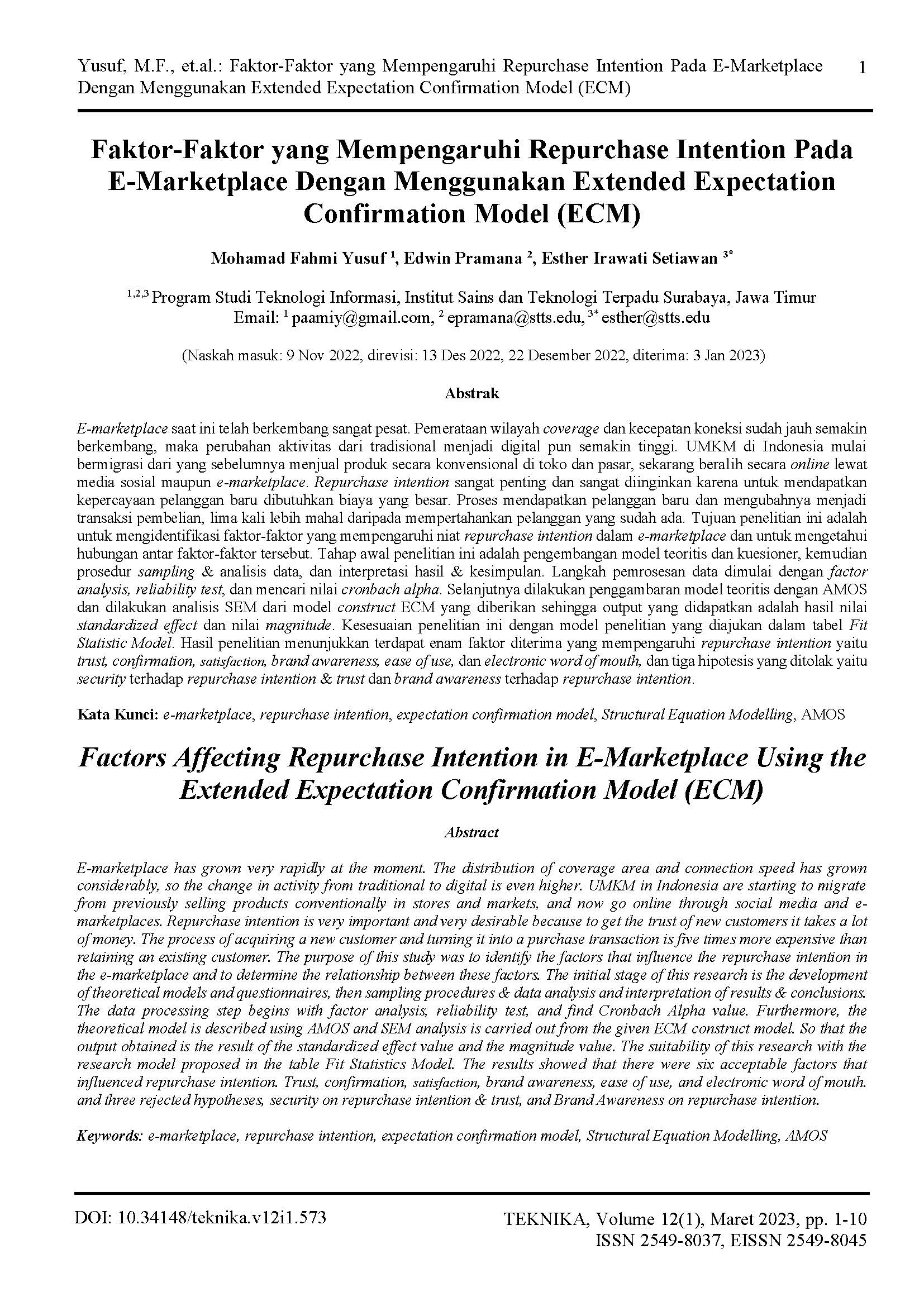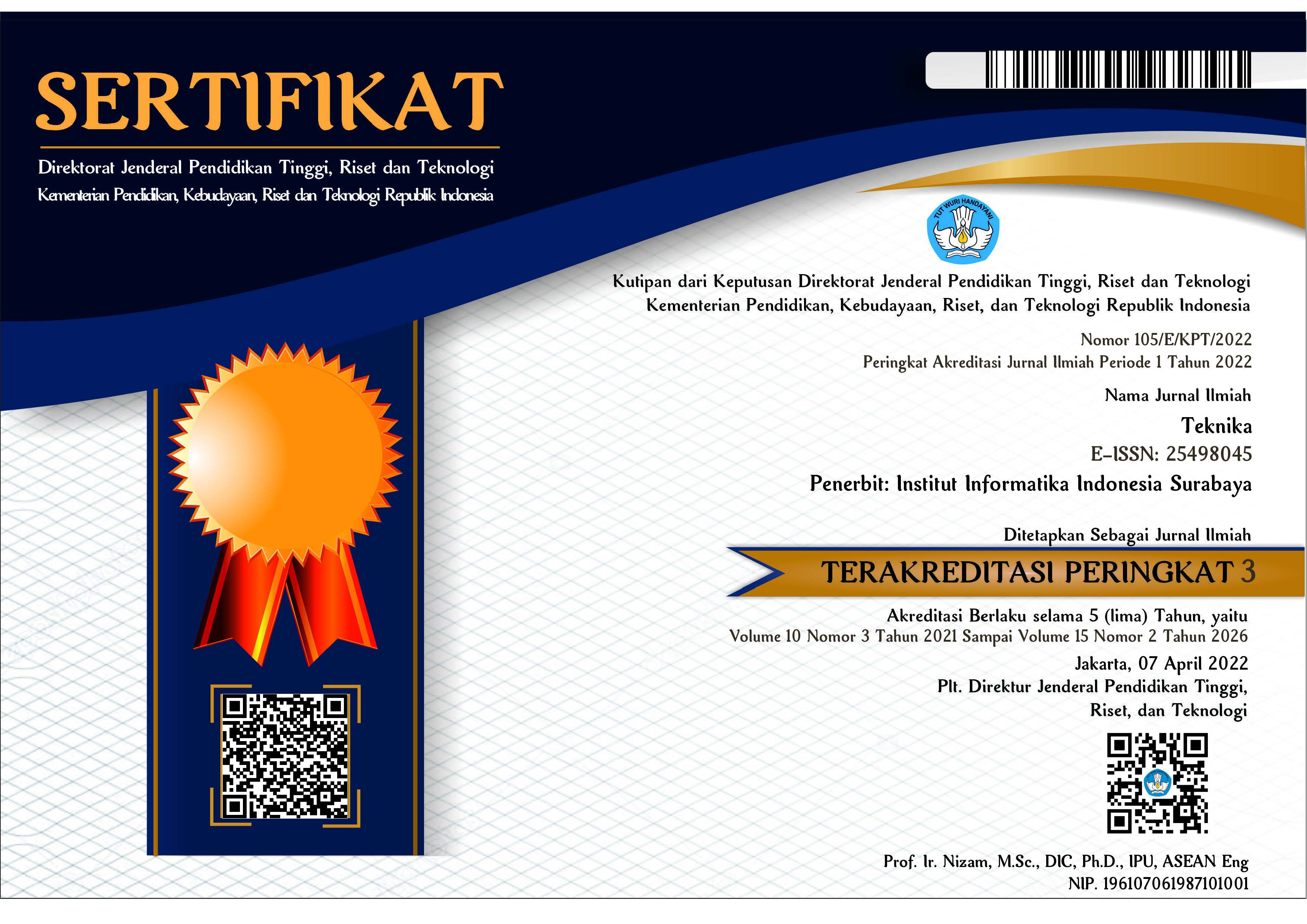Faktor-Faktor yang Mempengaruhi Repurchase Intention Pada E-Marketplace Dengan Menggunakan Extended Expectation Confirmation Model (ECM)
DOI:
https://doi.org/10.34148/teknika.v12i1.573Keywords:
e-marketplace, repurchase intention, expectation confirmation model, structural equation modelling, AMOSAbstract
E-marketplace saat ini telah berkembang sangat pesat. Pemerataan wilayah coverage dan kecepatan koneksi sudah jauh semakin berkembang, maka perubahan aktivitas dari tradisional menjadi digital pun semakin tinggi. UMKM di Indonesia mulai bermigrasi dari yang sebelumnya menjual produk secara konvensional di toko dan pasar, sekarang beralih secara online lewat media sosial maupun e-marketplace. Repurchase intention sangat penting dan sangat diinginkan karena untuk mendapatkan kepercayaan pelanggan baru dibutuhkan biaya yang besar. Proses mendapatkan pelanggan baru dan mengubahnya menjadi transaksi pembelian, lima kali lebih mahal daripada mempertahankan pelanggan yang sudah ada. Tujuan penelitian ini adalah untuk mengidentifikasi faktor-faktor yang mempengaruhi niat repurchase intention dalam e-marketplace dan untuk mengetahui hubungan antar faktor-faktor tersebut. Tahap awal penelitian ini adalah pengembangan model teoritis dan kuesioner, kemudian prosedur sampling & analisis data, dan interpretasi hasil & kesimpulan. Langkah pemrosesan data dimulai dengan factor analysis, reliability test, dan mencari nilai cronbach alpha. Selanjutnya dilakukan penggambaran model teoritis dengan AMOS dan dilakukan analisis SEM dari model construct ECM yang diberikan sehingga output yang didapatkan adalah hasil nilai standardized effect dan nilai magnitude. Kesesuaian penelitian ini dengan model penelitian yang diajukan dalam tabel Fit Statistic Model. Hasil penelitian menunjukkan terdapat enam faktor diterima yang mempengaruhi repurchase intention yaitu trust, confirmation, satisfaction, brand awareness, ease of use, dan electronic word of mouth, dan tiga hipotesis yang ditolak yaitu security terhadap repurchase intention & trust dan brand awareness terhadap repurchase intention.
Downloads
References
P. KOMINFO, “Kemkominfo: Pertumbuhan e-Commerce Indonesia Capai 78 Persen,” Website Resmi Kementerian Komunikasi dan Informatika RI. http:///content/detail/16770/kemkominfo-pertumbuhan-e-commerce-indonesiacapai-78-persen/0/sorotan_media (accessed Dec. 07, 2022).
S. K. Trivedi and M. Yadav, “Repurchase intentions in Y generation: mediation of trust and e-satisfaction,” MIP, vol. 38, no. 4, pp. 401—415, Feb. 2020, doi: 10.1108/MIP-02-2019-0072.
M. D. Johnson, A. Herrmann, and F. Huber, “The Evolution of Loyalty Intentions,” Journal of Marketing, vol. 70, no. 2, pp. 122—132, Apr. 2006, doi: 10.1509/jmkg.70.2.122.
F. F. Reichheld and P. Schefter, “E-Loyalty: Your Secret Weapon on the Web,” p. 12.
M. Parthasarathy and A. Bhattacherjee, “Understanding Post-Adoption Behavior in the Context of Online Services,” Information Systems Research, vol. 9, no. 4, pp. 362—379, Dec. 1998, doi: 10.1287/isre.9.4.362.
V. Marinkovic, V. Senic, D. Ivkov, D. Dimitrovski, and M. Bjelic, “The antecedents of satisfaction and revisit intentions for full-service restaurants,” Marketing Intelligence & Planning, vol. 32, no. 3, pp. 311—327, Apr. 2014, doi: 10.1108/MIP-01-2013-0017.
P. KOMINFO, “UMKM Naik Kelas, UMKM Go Digital,” Website Resmi Kementerian Komunikasi dan Informatika RI. http:///content/detail/41205/umkm-naik-kelas-umkm-go-digital/0/artikel (accessed Dec. 06, 2022).
W. Prahiawan, M. Fahlevi, J. Juliana, J. T. Purba, and S. A. Tarigan, “The role of e-satisfaction, e-word of mouth and e-trust on repurchase intention of online shop,” 10.5267/j.ijdns, vol. 5, no. 4, pp. 593—600, 2021, doi: 10.5267/j.ijdns.2021.8.008.
Dr. M. A. Sandhu, A. Saleem, and A. Ali, “The effects of Electronic Word Of Mouth (EWOM) and Brand-Awareness to govern the advancement of Brand Attitude towards the Brand Repurchase Intention: A case of Mobile brands in Pakistan,” iRASD J. Manag., vol. 3, no. 3, pp. 411—428, Dec. 2021, doi: 10.52131/jom.2021.0303.0055.
A. Tandon, A. Aakash, and A. G. Aggarwal, “Impact of EWOM, website quality, and product satisfaction on customer satisfaction and repurchase intention: moderating role of shipping and handling,” Int J Syst Assur Eng Manag, vol. 11, no. S2, pp. 349—356, Jul. 2020, doi: 10.1007/s13198-020-00954-3.
S. L. Jarvenpaa and P. A. Todd, “Consumer Reactions to Electronic Shopping on the World Wide Web,” International Journal of Electronic Commerce, vol. 1, no. 2, pp. 59—88, Dec. 1996, doi: 10.1080/10864415.1996.11518283.
S. S. CHA and S. H. LEE, “The Effects of User Experience Factors on Satisfaction and Repurchase Intention at Online Food Market,” The Journal of Industrial Distribution & Business, vol. 12, no. 4, pp. 7—13, Apr. 2021, doi: 10.13106/JIDB.2021.VOL12.NO4.7.
M.-S. Kim and J.-H. Ahn, “Management of Trust in the E-Marketplace: The Role of the Buyer’s Experience in Building Trust,” Journal of Information Technology, vol. 22, no. 2, pp. 119—132, Jun. 2007, doi: 10.1057/palgrave.jit.2000095.
M. Hume, G. S. Mort, and H. Winzar, “Exploring repurchase intention in a performing arts context: who comes? and why do they come back?,” Int. J. Nonprofit Volunt. Sect. Mark., vol. 12, no. 2, pp. 135—148, May 2007, doi: 10.1002/nvsm.284.
N. Archer and J. Gebauer, “B2B Applications to Support Business Transactions: Overview and Management Considerations,” in Business to Business Electronic Commerce, M. Warkentin, Ed. IGI Global, 2002, pp. 22—50. doi: 10.4018/978-1-930708-09-9.ch002.
A. Bhattacherjee, “Understanding Information Systems Continuance: An Expectation-Confirmation Model,” MIS Quarterly, vol. 25, no. 3, p. 351, Sep. 2001, doi: 10.2307/3250921.
M.-H. Hsu, C.-M. Chang, K.-K. Chu, and Y.-J. Lee, “Determinants of repurchase intention in online group-buying: The perspectives of DeLone & McLean IS success model and trust,” Computers in Human Behavior, vol. 36, pp. 234—245, Jul. 2014, doi: 10.1016/j.chb.2014.03.065.
Q. Pham, X. Tran, S. Misra, R. MaskeliÅ«nas, and R. DamaÅ¡eviÄius, “Relationship between Convenience, Perceived Value, and Repurchase Intention in Online Shopping in Vietnam,” Sustainability, vol. 10, no. 2, p. 156, Jan. 2018, doi: 10.3390/su10010156.
C. Kim, F. J. Costello, and K. C. Lee, “The Unobserved Heterogeneneous Influence of Gamification and Novelty-Seeking Traits on Consumers’ Repurchase Intention in the Omnichannel Retailing,” Front. Psychol., vol. 11, p. 1664, Jul. 2020, doi: 10.3389/fpsyg.2020.01664.
H. S. Du, J. Xu, H. Tang, and R. Jiang, “Repurchase Intention in Online Knowledge Service: The Brand Awareness Perspective,” Journal of Computer Information Systems, vol. 62, no. 1, pp. 174—185, Jan. 2022, doi: 10.1080/08874417.2020.1759159.
M. K. O. Lee and E. Turban, “A Trust Model for Consumer Internet Shopping,” International Journal of Electronic Commerce, vol. 6, no. 1, pp. 75—91, Sep. 2001, doi: 10.1080/10864415.2001.11044227.
R. C. Mayer, J. H. Davis, and F. D. Schoorman, “An Integrative Model Of Organizational Trust,” AMR, vol. 20, no. 3, pp. 709—734, Jul. 1995, doi: 10.5465/amr.1995.9508080335.
C. Wen, V. R. Prybutok, and C. Xu, “An Integrated Model for Customer Online Repurchase Intention,” null, vol. 52, no. 1, pp. 14—23, Sep. 2011, doi: 10.1080/08874417.2011.11645518.
J. Xu and Z. Liu, “Study of Online Stickiness: Its Antecedents and Effect on Repurchase Intention,” in 2010 International Conference on e-Education, e-Business, e-Management and e-Learning, Sanya, Jan. 2010, pp. 116—120. doi: 10.1109/IC4E.2010.42.
R. L. Oliver, “A Cognitive Model of the Antecedents and Consequences of Satisfaction Decisions,” Journal of Marketing Research, vol. 17, no. 4, pp. 460—469, Nov. 1980, doi: 10.1177/002224378001700405.
F. D. Davis, “Perceived Usefulness, Perceived Ease of Use, and User Acceptance of Information Technology,” MIS Quarterly, vol. 13, no. 3, p. 319, Sep. 1989, doi: 10.2307/249008.
R. A. King, P. Racherla, and V. D. Bush, “What We Know and Don’t Know About Online Word-of-Mouth: A Review and Synthesis of the Literature,” Journal of Interactive Marketing, vol. 28, no. 3, pp. 167—183, Aug. 2014, doi: 10.1016/j.intmar.2014.02.001.
“Determining sample size by Glen Israel.pdf.” Accessed: Dec. 07, 2022. [Online]. Available: https://www.psycholosphere.com/Determining%20sample%20size%20by%20Glen%20Israel.pdf
R. B. Kline, “Principles and Practice of Structural Equation Modeling,” p. 554.
“Statistical Power Analysis for the Behavioral Sciences | Jacob Cohen |.” https://www.taylorfrancis.com/books/mono/10.4324/9780203771587/statistical-power-analysis-behavioral-sciences-jacob-cohen (accessed Dec. 07, 2022).























